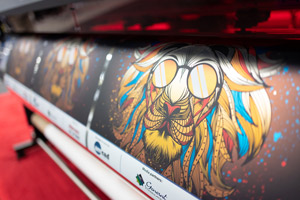 Navigating ink adhesion is a common issue in graphics production and across the printing industry. It’s likely that you’ve heard reports of ink not sticking or chipping when it comes time to cut the graphic out of the substrate. Or, maybe you’ve tried printing onto a new substrate and run into difficulties and didn’t know what to do. Well, the good news is there are a couple of important points to remember when facing this challenge.
Navigating ink adhesion is a common issue in graphics production and across the printing industry. It’s likely that you’ve heard reports of ink not sticking or chipping when it comes time to cut the graphic out of the substrate. Or, maybe you’ve tried printing onto a new substrate and run into difficulties and didn’t know what to do. Well, the good news is there are a couple of important points to remember when facing this challenge.While UV inks are used in a variety of devices and are touted as a great option to print onto different surfaces, it's important to understand the science behind adhesion.
First off, ink adhesion is all about the substrate’s surface energy and the ink’s surface tension — both expressed as their dyne level. (I can see you running for the hills now, but just give me a minute to quickly explain.) For me, the easy way to remember this is to think of water (with a dyne level around 72, which is high surface tension) and a wax coating on a car (which brings the surface energy down to a dyne level around 23). As you know, what happens is that the water just beads up and runs right off. What’s needed is a surface energy dyne (substrate) that is higher than the surface tension (ink); usually 10 dyne is a good rule of thumb. So, if the water had a surface tension of 25-35 dyne (which is typical for UV ink), and the substrate had a surface energy in the 35-45 dyne range, you would get good adhesion.
There are dyne pens or test kits that you can purchase to test a substrate, and, in the case of polystyrene that may be flame- or corona-treated to raise the surface energy, you should test when the product comes into your facility and again before printing. Some treatments to raise the surface energy will wear off over time, and you’ll be back to the problem of ink not adhering.
For substrates that have a low surface energy, primers can be used to facilitate adhesion. And, of course, some manufacturers have different “flavors” of ink that are designed to do a better job of adhering to different substrates. The bottom line is testing, testing, and more testing. Test substrates that you know have been treated and test any substrate that you are printing for the first time to see if a primer is necessary.
It is always important to communicate with the printer or ink manufacturer. They have done extensive testing, and the last thing they want is for you to have a job rejected because their ink didn’t hold up.
Now get out there and print something!
 Since joining PRINTING United Alliance in 2014, Ray Weiss has assisted members with information on digital printing as well as digital equipment, materials, and vendor referrals. While overseeing the Alliance's training and certification workshops, he regularly contributes to the PRINTING United Journal and won the 2016 Swormstedt Award for Best in Class writing in the Digital Printing category. Ray was inducted into the Academy of Screen and Digital Printing Technologies (ASDPT) in 2020. He also works with SkillsUSA to conduct the National Competition for Graphics Imaging Sublimation.
Since joining PRINTING United Alliance in 2014, Ray Weiss has assisted members with information on digital printing as well as digital equipment, materials, and vendor referrals. While overseeing the Alliance's training and certification workshops, he regularly contributes to the PRINTING United Journal and won the 2016 Swormstedt Award for Best in Class writing in the Digital Printing category. Ray was inducted into the Academy of Screen and Digital Printing Technologies (ASDPT) in 2020. He also works with SkillsUSA to conduct the National Competition for Graphics Imaging Sublimation.